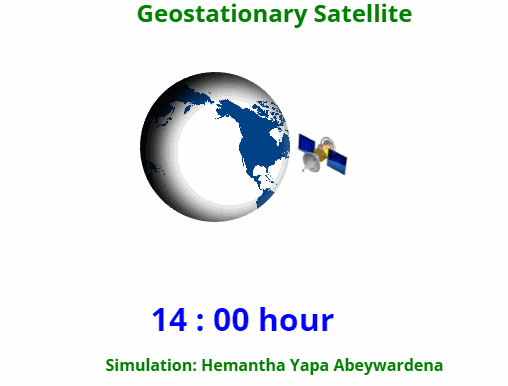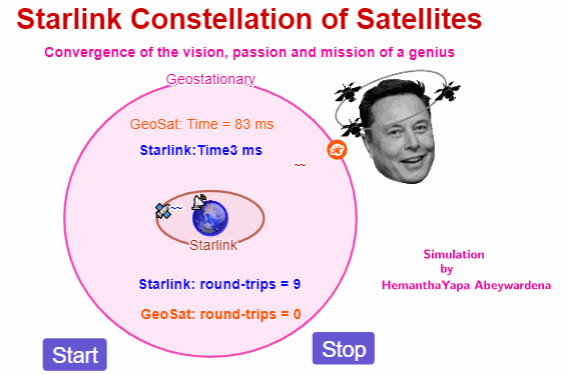Elon Musk: the only Earthling who owns a constellation! – By Hemantha Yapa Abeywardena


Santa Claus, who annually delights us, both kids and adults alike, appears to be getting a rival for the grand constellation show – finally.
There is a new man in town, who claims – quite rightly and legally, of course – that he owns a constellation of satellites. Up until now, theists used to believe only the Almighty owned them – all of them!
Elon Musk, who holds the shifting-title, the world’s richest man, undoubtedly is a genius in the calibre of Newton, Tesla, Edison and many more, who helped mankind making progress in leaps and bounds during the passage of time with many things that we take for granted today; if there is sub-species under sapiens in the human taxonomy chain as ‘geniuses’, Mr Musk certainly has an undisputed slot in it.
Of course, there are millions of electrical engineers and computer programmers in the world and the number grows by the hour. Yet, who would have thought a decade or so ago, creating a constellation of satellites to provide the internet access to the remotest corners of this planet?
That’s a vision and only do visionaries, not necessarily the pure intellectuals, get ideas of this kind, perhaps straight from ether. Mr Musk, an electrical engineer by profession, co-created PayPal, the digital paying platform, exactly the same way that in turn made online payments, a breeze.
Up until Starlink constellation, developed by SpaceX, came to prominence, satellites, known as geostationary satellites had been the main means of sending data from a specific point on the Earth to another point.
A geostationary satellite, envisioned by Sir Arthur C Clarke in the late 1940’s, is orbiting the Earth at a staggering altitude of 35,780km. At this specific altitude, in a special orbit known as Clarke’s Belt – named in honour of Sir Arthur C Clarke, a satellite moves in the orbit at the same speed as that of the Earth rotational speed around its own axis, taking just 24 hours.

That means, a geostationary satellite remains ‘stationary’ relative to the Earth, leaving it as a celestial possession of the country beneath it, making the communication, to and from, smooth and quick.
There is a major challenge, though: although signals move at the speed of light – 3 x 108 meters/second – it takes, on average, 240 milliseconds for signals to make the round trip, known as latency; since the orbit in question is not a perfect circle, more of an ellipse in shape, the latency, in reality, can be as high as 600ms.
The latency, in this context, is a serious drawback, especially for those who want to use data-intensive applications, do video conferences and play games: it may take ages for your average aunt, say Mrs Dorothy Threadbare, for instance, to load up her favourite cat video, if she chooses to live in a remote part of the Earth; this is the time, when the gamers spew expletive-laden rants at computer screens, as the frustration crosses their self-imposed redlines.
The satellites in the Starlink constellation, by contrast, are in orbits at an altitude of about 550 km, much lower than that of a geostationary satellite; they are LEOs – Low Earth Orbit – satellites. Thanks to closeness to the surface of the Earth, the latency of a satellite in Starlink constellation ranges between 30 to 40 milliseconds.

On Sunday, June 2, Mr Musk announced reaching yet another milestone as far as Starlink constellation is concerned: he said the internal median latency now stands at 28 milliseconds, thanks to the improved ground infrastructure, coupled with network routing and software upgrades; Mr Musk wants to keep the crucial figure below 20 milliseconds in the long run; if achieved, it can rival even the terrestrial fibre optic networks.
This dramatic reduction in latency is a game-changer, indeed. Users in remote locations, previously lacking reliable internet, can now experience high-speed browsing, streaming, and online interaction. Starlink is particularly beneficial for geographically isolated communities, disaster zones, and even airplanes and ships seeking internet connectivity on the go.
In addition, Mr Musk plans to make the access of Starlink, in his own words, super easy: easy contracts with an equally easy, no-question-asked cancellation-at-any -time policy.
Starlink, the mega constellation developed by SpaceX, has revolutionized the internet access in the remote corners and underserved areas of the Earth, even in the developed world, where ISPs, internet service providers, are not keen on extending the existing networks to those places for obvious reasons. The innovative systems of SpaceX are promising to bridge the digital divide in the coming years.
At present, Starlink boasts having around 6000 satellites in its constellation that is going to grow by tens of thousands more in the coming years.
The sheer number of satellites in Starlink constellation, however, raises eyebrows in some domains: there is a strong possibility of the satellites, according to them, colliding with existing space junk, adding more debris to the existing piles that could hinder space exploration; in addition, when the satellites move as if they were a part of a space train, light pollution can make the astronomer’s job of spotting dimmer objects far out in deep space, quite difficult.
These concerns show the need of international regulations and collaborations to ensure responsible deployment practices, mitigation of space debris and of course, keeping the light pollution at bay. An approach of this kind with international corporation will certainly result in the co-existence of space exploration with astronomical research that breeds innovation.
SpaceX, on its part, is taking steps to strike a balance between technological progress and environmental sustainability: their satellites, for instance, are equipped with autonomous collision avoidance systems and are designed to de-orbit naturally within five years, minimizing long-term space debris. SpaceX is also developing darker satellite visors to reduce light reflectivity.
Light pollution, unfortunately, has already become an impediment to stargazers in major cities around the world; for future generations, spotting a star in a major city, literally, will be once in a blue moon.
If the combination of light pollution and the issue with the space debris, however, eclipses the innovative leaps of SpaceX, it is going to be a major headache for the men and women who channel their energies to make the digital divide narrower.
If arguments against the immense contribution that SpaceX keeps making takes precedence over its immense benefits, in the absence of a balance is struck, it is like accusing the Saturn, the beautiful planet, of committing polygamy, just because it has many rings!







